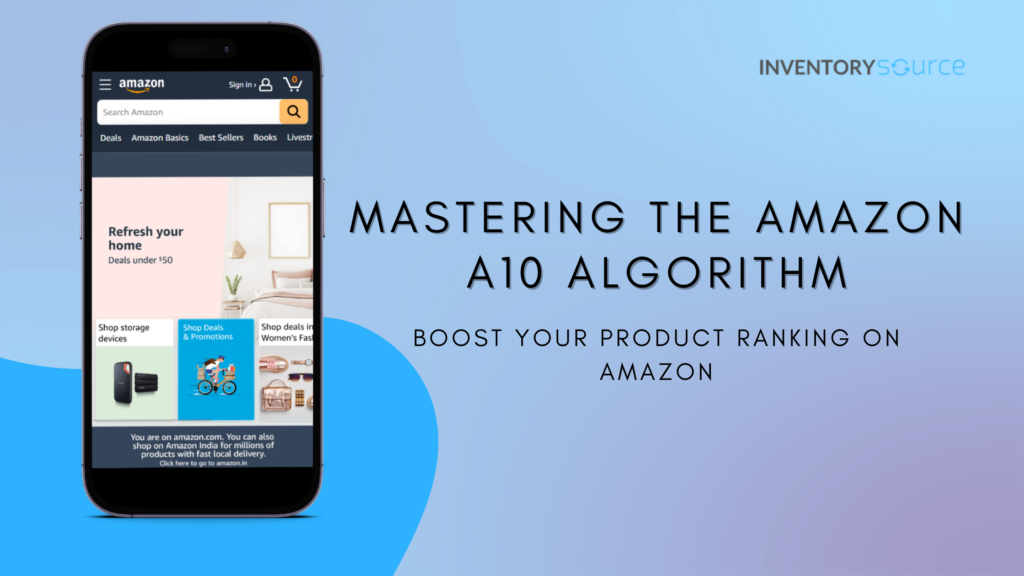Mastering the Amazon A10 Algorithm: Boost Your Product Ranking on Amazon
Understanding the Amazon A10 Algorithm is crucial for success as an Amazon seller. This algorithm is like a smart helper that decides which products to show when shoppers search on Amazon. In this guide, we’ll break down how it works and share tips to improve your product ranking.
What is the Amazon A10 Algorithm?
Your Shopping Assistant
Think of the Amazon A10 Algorithm as your friendly shopping assistant on Amazon. It’s like having someone who knows exactly what you want to buy and helps you find it effortlessly.
How It Works
The A10 Algorithm watches what customers do on Amazon. It pays attention to what they click on and what they end up buying. It also looks at the words in a product’s title and description to see if they match what customers are searching for. Simply put, it’s like a helpful guide ensuring you see products you’re interested in.
How Does the Amazon A10 Algorithm Work?
Your Personal Store Assistant
Imagine you’re in a huge store with countless items, and you’re searching for something specific, like blue running shoes. The Amazon A10 Algorithm is like a friendly store assistant there to help you.
Customer Searches: It all starts when you type your search query into Amazon. If you’re looking for “blue running shoes,” the A10 Algorithm springs into action.
Relevance Check: The algorithm’s first job is to find products that match what you’re searching for. It’s like the assistant quickly scanning the store to locate the section with blue running shoes.
Customer Behavior: Now, picture this assistant as someone who has worked in the store for a long time. They know what shoes other customers have bought when searching for blue running shoes. So, they might suggest those shoes to you because they’re popular.
Keywords: This assistant is also like a word expert. They carefully read the labels on the shoeboxes to see if the words “blue,” “running,” and “shoes” are there. If they are, it’s a good match, just like finding a puzzle piece that fits perfectly.
Ranking: Finally, this assistant organizes the shoes based on all these things. They put the ones that are the best match and most popular at the very top of the shelf. It’s like putting the most delicious cookies on the top shelf so you see them first.
In simple terms, the Amazon A10 Algorithm is like your shopping buddy. It looks at what you’re searching for, what other people have liked, and the words on product labels to help you find the perfect product. It’s all about making your shopping experience easier and more enjoyable.
How Does Amazon Product Ranking Work?
A Popularity Contest
Amazon product ranking is like a popularity contest for products on the platform. The goal is to ensure that when a customer searches for something, they see the most relevant and appealing products at the top of the search results. Here’s how it works:
Keywords and Relevance: Amazon pays attention to the words customers use when they search. For instance, if someone searches for “wireless headphones,” Amazon wants to show them wireless headphones, not soccer balls. So, products with the right keywords in their titles and descriptions have an advantage.
Customer Behavior: Amazon closely watches what customers do. If lots of people click on a particular product and buy it after seeing it in the search results, that product gets a thumbs-up. This tells Amazon that the product is probably a good match for that search query.
Conversion Rate: Conversion rate means the percentage of people who actually buy a product after clicking on it. If many people click on a product and buy it, that’s a strong signal to Amazon that the product should rank higher.
Sales History: Amazon also considers a product’s sales history. If a product has been selling well over time, it’s seen as more reliable and might rank higher.
Customer Reviews: Reviews from customers matter too. Products with lots of positive reviews tend to rank better because they show that people like the product.
Images and Descriptions: The way a product is presented matters. High-quality images and detailed descriptions can make a product more appealing, which can improve its ranking.
Pricing and Availability: Competitive pricing and keeping products in stock are important. If a product is priced well and always available, it’s more likely to rank higher.
Amazon Sponsored Products: Sellers can also pay Amazon to have their products shown more prominently in search results through sponsored listings. This can give a product a boost in visibility.
What is the Difference between Amazon A9 and A10 Algorithms?
Amazon A9 Algorithm:
- Older Version: A9 is the older of the two algorithms, having been used by Amazon for several years.
- Keyword-Focused: A9 primarily relies on keywords in product listings and customer search queries to determine rankings.
- Simplified Approach: It has a simpler approach to ranking, with less emphasis on factors like customer behavior and historical data.
- Search Term Relevance: A9 places a strong emphasis on matching the search terms used by customers with the words in product titles and descriptions.
- Limited Personalization: Personalization of search results based on individual customer behavior is not as prominent in A9.
Amazon A10 Algorithm:
- Newer Version: A10 is the newer and more advanced algorithm, designed to provide better and more personalized search results.
- Behavior-Driven: A10 takes into account not just keywords but also customer behavior, such as click-through rates and conversion rates, to determine rankings.
- Machine Learning: It utilizes machine learning and artificial intelligence techniques to adapt and improve search results over time.
- Personalization: A10 places a strong emphasis on personalizing search results for each customer, aiming to show them products they are more likely to buy.
- Dynamic and Evolving: A10 is continuously updated and refined by Amazon to ensure it stays up-to-date with changing customer preferences and market trends.
- Wider Data Set: A10 considers a broader range of data, including historical customer interactions and product attributes, to provide more relevant search results.
How To Improve Product Ranking On Amazon In the A10 Algorithm
A Step-By-Step Guide to Success:
Improving your Amazon ranking in the A10 Algorithm involves a mix of smart strategies and attention to detail. Here’s a step-by-step guide:
Keyword Optimization:
Use Relevant Keywords: Research and include the most relevant keywords in your product titles, descriptions, and backend search terms. Think about what words customers would use when searching for your product.
Avoid Keyword Stuffing: While using keywords is crucial, don’t overdo it. Make sure your content reads naturally and provides value to customers.
Enhance Product Titles:
Make Titles Descriptive: Craft clear and concise product titles that accurately describe your item. Include key product features, size, color, and brand.
Frontload Keywords: Place important keywords near the beginning of the title to catch the algorithm’s attention.
Product Descriptions:
Be Detailed: Write informative and engaging product descriptions. Try to explain how your product solves a problem or fulfills a need of customer.
Benefits Over Features: Focus on the benefits customers will get from your product rather than just listing features.
High-Quality Images:
Use Clear and High-Resolution Images: Upload images that show your product from different angles and in various contexts. High-quality visuals can boost conversion rates.
Price Competitively and Offer Value:
Competitive Pricing: Keep an eye on your competitors’ prices and offer a competitive rate. Amazon shoppers often compare prices before making a purchase.
Bundles and Deals: Consider offering bundles or discounts for multiple purchases to entice buyers.
Customer Reviews and Ratings:
Encourage Reviews: Encourage satisfied customers to leave positive reviews. Respond to negative reviews professionally and address customer concerns promptly.
Maintain High Quality: Ensure your product meets or exceeds customer expectations to build a strong review history.
Fulfillment and Shipping:
Use Fulfillment by Amazon (FBA): Amazon FBA can improve your shipping speed and reliability, which can positively influence your ranking.
Fast and Accurate Shipping: Ship orders quickly and accurately to maintain high customer satisfaction.
Sponsored Products:
Utilize Amazon PPC Campaigns: Run Amazon Sponsored Products campaigns to promote your listings. This can boost visibility and sales.
Monitor and Adapt:
Keep an Eye on Performance: Regularly check your product’s performance metrics, including conversion rates and click-through rates.
Adjust Strategies: Based on the data you collect, adjust your strategies. This might involve refining your keywords, enhancing your product listings, or tweaking pricing.
Stay Updated:
Stay Informed: Keep up-to-date with changes in Amazon’s policies and the A10 Algorithm. Amazon often introduces updates, and staying informed can help you adapt your strategy accordingly.
In conclusion, understanding the Amazon A10 Algorithm and implementing effective strategies is crucial for success as an Amazon seller. By optimizing your product listings and staying informed about algorithm updates, you can improve your product ranking and ultimately grow your business. Additionally, exploring the world of dropshipping and leveraging automation tools like Inventory Source can further enhance your efficiency as a seller on Amazon.
Amazon A10 Algorithm FAQs
How has the Amazon A10 algorithm evolved from its predecessors?
The Amazon A10 algorithm has evolved significantly from its predecessors, like A9. It’s more advanced, incorporating machine learning, considering customer behavior, and focusing on personalization, making it better at delivering tailored search results.
What factors does the Amazon A10 algorithm consider when determining search rankings and product visibility?
The Amazon A10 algorithm takes into account various factors when determining search rankings and product visibility. These include keywords, customer behavior (clicks, purchases), conversion rates, sales history, customer reviews, image quality, pricing, and availability.
What is the role of relevancy in the A10 algorithm and how it impacts search results?
Relevancy is a crucial factor in the A10 algorithm. It ensures that products displayed in search results match what customers are searching for. Products with relevant keywords in their titles and descriptions are more likely to rank higher and be shown to potential buyers.
How does the concept of "conversion rate optimization" tie into the Amazon A10 algorithm's workings?
Conversion rate optimization is vital in the Amazon A10 algorithm’s workings. It measures the percentage of people who buy a product after clicking on it. High conversion rates indicate that a product is a good match for a search query, leading to improved rankings and visibility in search results.



